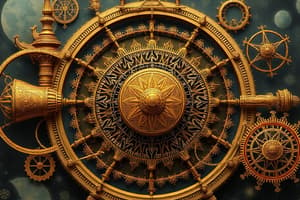Podcast
Questions and Answers
न्यूटन का पहला नियम किस अवधारणा को परिभाषित करता है?
न्यूटन का पहला नियम किस अवधारणा को परिभाषित करता है?
- ऊर्जा का संरक्षण
- जड़त्व (correct)
- विद्युत आवेश
- एन्ट्रापी
ऊष्मा हमेशा ठंडी वस्तुओं से गर्म वस्तुओं की ओर स्वाभाविक रूप से प्रवाहित होती है।
ऊष्मा हमेशा ठंडी वस्तुओं से गर्म वस्तुओं की ओर स्वाभाविक रूप से प्रवाहित होती है।
False (B)
ऊष्मप्रवैगिकी का कौन सा नियम एन्ट्रापी की अवधारणा को प्रस्तुत करता है?
ऊष्मप्रवैगिकी का कौन सा नियम एन्ट्रापी की अवधारणा को प्रस्तुत करता है?
दूसरा नियम
न्यूटन के गति के दूसरे नियम के अनुसार, किसी वस्तु का त्वरण उस पर लगने वाले शुद्ध बल के सीधे आनुपातिक होता है और उसके ___________ के विपरीत आनुपातिक होता है।
न्यूटन के गति के दूसरे नियम के अनुसार, किसी वस्तु का त्वरण उस पर लगने वाले शुद्ध बल के सीधे आनुपातिक होता है और उसके ___________ के विपरीत आनुपातिक होता है।
निम्नलिखित भौतिकी क्षेत्रों को उनके संबंधित विवरणों से मिलाएँ:
निम्नलिखित भौतिकी क्षेत्रों को उनके संबंधित विवरणों से मिलाएँ:
विद्युत चुम्बकीय विकिरण का आधार क्या है?
विद्युत चुम्बकीय विकिरण का आधार क्या है?
न्यूटन का तीसरा नियम बताता है कि प्रत्येक क्रिया के लिए एक समान लेकिन विपरीत प्रतिक्रिया होती है।
न्यूटन का तीसरा नियम बताता है कि प्रत्येक क्रिया के लिए एक समान लेकिन विपरीत प्रतिक्रिया होती है।
प्रकाश का कौन सा व्यवहार एक माध्यम से दूसरे माध्यम में जाते समय प्रकाश के मुड़ने का वर्णन करता है?
प्रकाश का कौन सा व्यवहार एक माध्यम से दूसरे माध्यम में जाते समय प्रकाश के मुड़ने का वर्णन करता है?
ऊष्मप्रवैगिकी का ___________ नियम बताता है कि जैसे-जैसे किसी प्रणाली का तापमान पूर्ण शून्य के करीब आता है, एन्ट्रापी एक स्थिर मान तक पहुँच जाती है।
ऊष्मप्रवैगिकी का ___________ नियम बताता है कि जैसे-जैसे किसी प्रणाली का तापमान पूर्ण शून्य के करीब आता है, एन्ट्रापी एक स्थिर मान तक पहुँच जाती है।
प्रकाशिक उपकरणों (optical instruments) को डिजाइन करने में प्रकाश के व्यवहार को समझना क्यों महत्वपूर्ण है?
प्रकाशिक उपकरणों (optical instruments) को डिजाइन करने में प्रकाश के व्यवहार को समझना क्यों महत्वपूर्ण है?
क्वांटम यांत्रिकी और शास्त्रीय यांत्रिकी (classical mechanics) समान पैमाने पर समान व्यवहार करते हैं।
क्वांटम यांत्रिकी और शास्त्रीय यांत्रिकी (classical mechanics) समान पैमाने पर समान व्यवहार करते हैं।
क्वांटम यांत्रिकी में तरंग-कण द्वैत (wave-particle duality) क्या है?
क्वांटम यांत्रिकी में तरंग-कण द्वैत (wave-particle duality) क्या है?
विशेष सापेक्षता (special relativity) जड़त्वीय पर्यवेक्षकों (inertial observers) के लिए _________ और _________ के बीच संबंधों का वर्णन करती है।
विशेष सापेक्षता (special relativity) जड़त्वीय पर्यवेक्षकों (inertial observers) के लिए _________ और _________ के बीच संबंधों का वर्णन करती है।
निम्नलिखित अवधारणाओं को उनके विवरण के साथ मिलाएं:
निम्नलिखित अवधारणाओं को उनके विवरण के साथ मिलाएं:
निम्नलिखित में से कौनसा सामान्य सापेक्षता (General relativity) का अनुप्रयोग है?
निम्नलिखित में से कौनसा सामान्य सापेक्षता (General relativity) का अनुप्रयोग है?
सामान्य सापेक्षता गुरुत्वाकर्षण (gravity) को द्रव्यमान और ऊर्जा द्वारा निर्मित स्पेसटाइम (spacetime) के वक्रता के रूप में वर्णित करती है।
सामान्य सापेक्षता गुरुत्वाकर्षण (gravity) को द्रव्यमान और ऊर्जा द्वारा निर्मित स्पेसटाइम (spacetime) के वक्रता के रूप में वर्णित करती है।
क्वांटम यांत्रिकी के दो प्रमुख अनुप्रयोगों का उल्लेख करें।
क्वांटम यांत्रिकी के दो प्रमुख अनुप्रयोगों का उल्लेख करें।
विशेष सापेक्षता _______ पर्यवेक्षकों के लिए अंतरिक्ष और समय के बीच संबंधों का वर्णन करती है, और _______ और _______ की अवधारणाओं को पेश करती है।
विशेष सापेक्षता _______ पर्यवेक्षकों के लिए अंतरिक्ष और समय के बीच संबंधों का वर्णन करती है, और _______ और _______ की अवधारणाओं को पेश करती है।
Flashcards
प्रकाश का व्यवहार
प्रकाश का व्यवहार
प्रकाश का अध्ययन महत्वपूर्ण है विभिन्न ऑप्टिकल उपकरणों को डिजाइन करने के लिए।
क्वांटम यांत्रिकी
क्वांटम यांत्रिकी
क्वांटम यांत्रिकी परमाणु और उप-परमाणु स्तर पर पदार्थ और ऊर्जा के व्यवहार का वर्णन करता है।
लहर- कण द्वैतता
लहर- कण द्वैतता
क्वांटम यांत्रिकी में कण कभी-कभी लहर जैसी विशेषताएँ दिखाते हैं।
ऊर्जा की क्वांटाइजेशन
ऊर्जा की क्वांटाइजेशन
Signup and view all the flashcards
अनिश्चितता का सिद्धांत
अनिश्चितता का सिद्धांत
Signup and view all the flashcards
सापेक्षता के सिद्धांत
सापेक्षता के सिद्धांत
Signup and view all the flashcards
समय का खिंचाव
समय का खिंचाव
Signup and view all the flashcards
गुरुत्वाकर्षण
गुरुत्वाकर्षण
Signup and view all the flashcards
जीपीएस प्रणाली
जीपीएस प्रणाली
Signup and view all the flashcards
न्यूटन का पहला नियम
न्यूटन का पहला नियम
Signup and view all the flashcards
फोर्स-मैस (F=ma)
फोर्स-मैस (F=ma)
Signup and view all the flashcards
न्यूटन का तीसरा नियम
न्यूटन का तीसरा नियम
Signup and view all the flashcards
इंसार्टिया
इंसार्टिया
Signup and view all the flashcards
थर्मल संतुलन
थर्मल संतुलन
Signup and view all the flashcards
एंट्रॉपी
एंट्रॉपी
Signup and view all the flashcards
इलेक्ट्रोमैग्नेटिज़्म
इलेक्ट्रोमैग्नेटिज़्म
Signup and view all the flashcards
परावर्तन
परावर्तन
Signup and view all the flashcards
अपवर्तन
अपवर्तन
Signup and view all the flashcards
Study Notes
Classical Mechanics
- Classical mechanics describes the motion of macroscopic objects, from projectiles to planets, using Newton's laws of motion.
- Newton's first law states that an object at rest stays at rest and an object in motion stays in motion with the same speed and in the same direction unless acted upon by an unbalanced force.
- Newton's second law states that the acceleration of an object is directly proportional to the net force acting on it and inversely proportional to its mass. (F = ma)
- Newton's third law states that for every action, there is an equal and opposite reaction.
- Concepts like inertia, momentum, and energy are fundamental to understanding motion in classical mechanics.
- Applications include calculating trajectories of projectiles, analyzing systems of interacting objects, and determining the motion of celestial bodies.
Thermodynamics
- Thermodynamics deals with heat, energy, and work and their relationship to physical systems.
- The Zeroth Law establishes a concept of thermal equilibrium.
- The First Law describes the conservation of energy in thermodynamic processes, stating that energy can neither be created nor destroyed, only converted from one form to another.
- The Second Law introduces the concept of entropy, which quantifies the degree of disorder in a system, and generally dictates the direction of spontaneous processes. Heat naturally flows from hot objects to cold objects.
- The Third Law describes the behavior of systems as their temperature approaches absolute zero; entropy approaches a constant value.
- Applications include engines, refrigerators, and other thermal devices.
Electromagnetism
- Electromagnetism is the study of electric and magnetic fields and their interactions.
- Electric charges create electric fields, which exert forces on other charges.
- Moving charges create magnetic fields, which exert forces on other moving charges.
- Electric and magnetic fields are related, and a changing magnetic field can create an electric field, and vice versa.
- This phenomenon is the basis of electromagnetic radiation, including light.
- Applications include electricity generation, electronics, and communication technologies.
Optics
- Optics deals with the behavior of light, including reflection, refraction, and diffraction.
- Reflection is the bouncing of light off a surface.
- Refraction is the bending of light as it passes from one medium to another.
- Diffraction is the spreading of light as it passes through an aperture or around an obstacle.
- Understanding the behavior of light is crucial in designing optical instruments like lenses and telescopes.
- Applications include designing cameras, microscopes, and optical fibers.
Quantum Mechanics
- Quantum mechanics describes the behavior of matter and energy at the atomic and subatomic level.
- It differs significantly from classical mechanics at these scales.
- Quantum mechanics introduces concepts like wave-particle duality, where particles can exhibit wave-like properties and vice versa.
- Concepts like quantization of energy, uncertainty principle, and wave functions are central to this field.
- Applications include understanding atomic structure, developing transistors, and creating lasers.
Relativity
- Relativity encompasses special and general theories.
- Special relativity describes the relationships between space and time for inertial observers and introduces concepts of time dilation and length contraction.
- General relativity describes gravity as a curvature of spacetime caused by mass and energy.
- Applications include GPS systems, understanding the behavior of black holes and neutron stars, and cosmological models.
Studying That Suits You
Use AI to generate personalized quizzes and flashcards to suit your learning preferences.
Description
क्लासिकल मैकेनिक्स स्थूल वस्तुओं की गति का वर्णन करता है, जैसे प्रक्षेप्य से लेकर ग्रह तक, न्यूटन के गति के नियमों का उपयोग करना। थर्मोडायनामिक्स गर्मी, ऊर्जा और कार्य और भौतिक प्रणालियों के साथ उनके संबंध से संबंधित है।




